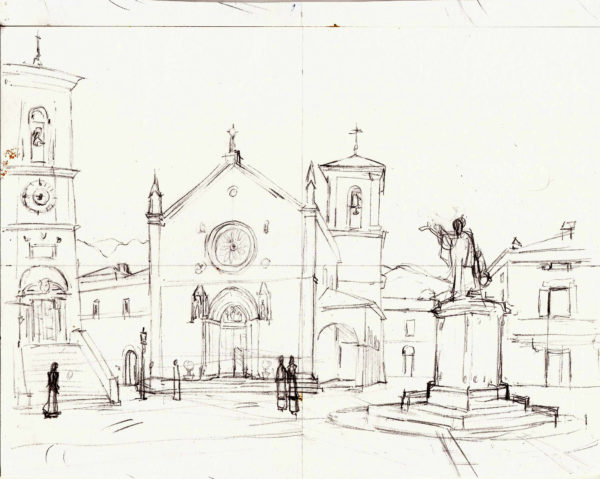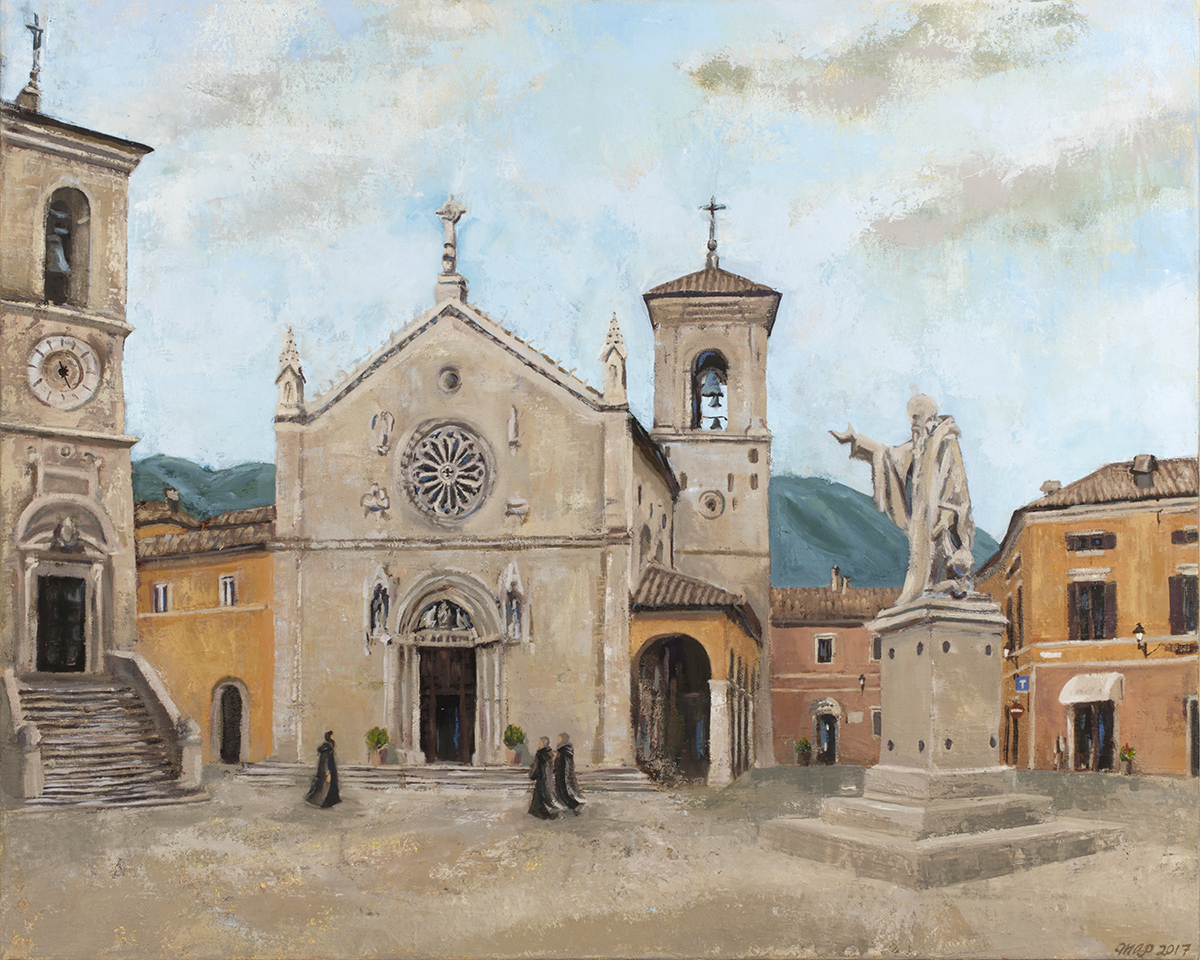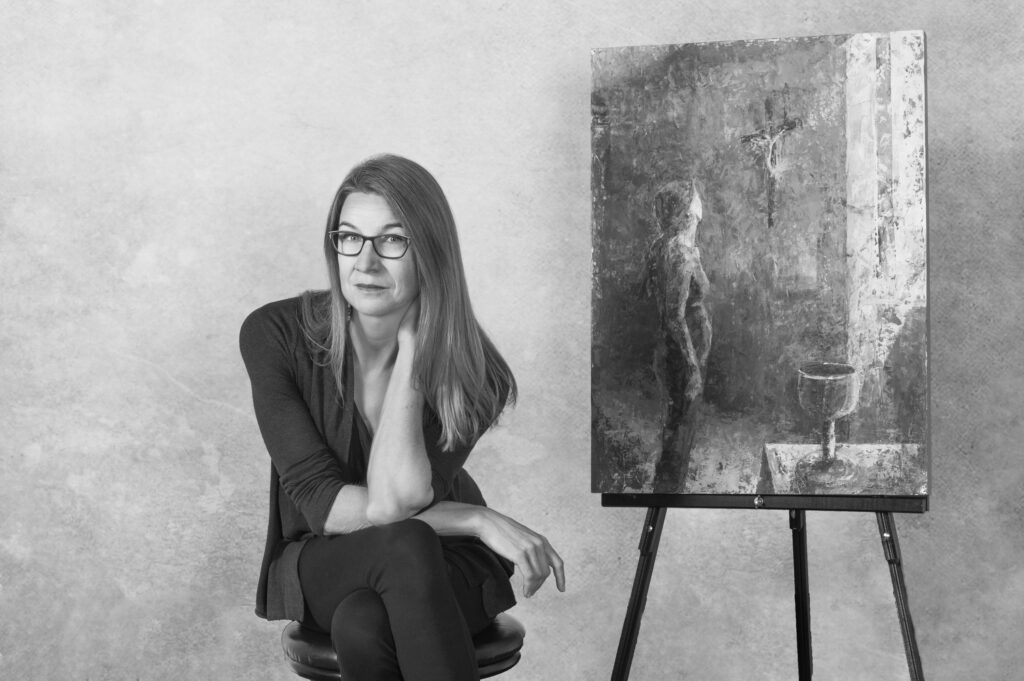
A Painting to Remember the Basilica of Norcia
A year ago I wrote about the destruction waged by earthquakes in central Italy, and the destruction of the Basilica of Norcia, home to the Benedictine Monks of Norcia, whose community was founded on the birthplace of the Saint Benedict and his sister, Saint Scholastica.
Last winter some friends of the Monks here in Northwest Ohio approached me about painting the (now destroyed) Basilica of St. Benedict in Norcia so they could have a permanent memory of that sacred place in their home. I have received many commissions to paint the places which form the architecture of our lives and was happy to take on the project.
Collecting Reference Material
Thankfully they had plenty of photos from numerous trips to Norcia to visit the monks. Even had I been able to visit in person to research the painting, it would not have helped much, since after the earthquakes the roof of the Basilica caved in, the bell tower collapsed and the facade is now held up only by scaffolding. The statue of St. Benedict in the main piazza remains but much of the town remains in a state of damage and rebuilding is slowed down by bureaucracy.

Preparatory Drawing for Basilica of St. Benedict Painting, ©Michelle Arnold Paine 2017, 8″ x 10″
Preparatory Drawing
As with most paintings, but especially when I am working on a commission, I begin with a drawing. I was trying to piece together the viewpoint of the piazza from a series of photos which weren’t taken for this purpose, so we had to puzzle it together. My drawing had to create from imagination a point of view in which the statue of St. Benedict was not too short and not too tall in relationship to the Basilica, and also not overlapping it. You can see on top of the statue’s head where I erased an earlier, taller version of the statue that seemed too much in competition with the belltower of the basilica.
To transfer the drawing to the canvas I used the same technique I teach in the first week of the Drawing I class: dividing a drawing into quadrants to accurately transcribe size and shape relationships to another surface. You can see where I drew the horizontals and verticals in the pencil drawing. In the early version of the painting, below, you can see where I painted them onto the canvas, as well.

Basilica of Saint Benedict IN PROGRESS, Oil on Canvas ©Michelle Arnold Paine, 24″ x 30″
Underpainting
I began the painting by toning the white canvas with a thin glaze of yellow. I chose a color on the opposite end of the color wheel from the blue-purple gray of the stone that would dominate the finished painting. Having bits of the complementary color peeking through the finished painting often helps create vibrancy of color relationships. After finalizing the placements of the main elements of the composition (basilica, statue, monastery, etc) with the patrons, I sketched out the composition on the canvas using the quadrant method mentioned above.
As the painting moved along, I realized too much of the composition was taken up by the flat paving stones of the piazza, empty of people. I wanted to move everything down three inches, giving more space in the composition to the sky. I had already painted so much! In order to determine if this was the right thing to do, you can see that I actually cut off the bottom and pasted it to the top of the drawing, removing some of the piazza and adding more to the sky. Easier to try this out on a piece of paper than on a large canvas!

Basilica of Saint Benedict, Norcia, OIl on Canvas 24″ x 30″, IN PROGRESS. ©Michelle Arnold Paine 2017
Dialogue about the Details
I developed the texture of sky and stone, adjusted color of the distant Umbrian mountains in relation to the ceramic tile roofs and stucco buildings. I moved towards the finishing point and presented an almost finished version to the patrons. In consulting with them we determined that perhaps the painting was too devoid of life. We didn’t want the painting to reflect the eery emptiness that dominates post-Earthquake Norcia now. I had edited out a great deal of modern “additions” to the landscape which seemed to be distracting from the medieval church, but we decided I had edited too much. Elements such as flowerpots, Tabacchi signs and street signs are important signs of everyday Italian life.
The piazza in front of the Basilica also seemed to be TOO empty. Perhaps it needed some figures. But would we include 21st Italian “ragazzi” chatting and smoking their cigarettes? The patrons suggested the three monks walking towards the front door of the basilica. These three figures represent the first three monks who began the community in Norcia the year 2000.
I am so grateful for the feedback and collaborative process of the ongoing dialogue with the patrons. It pushed me towards a better painting, and it ensured that they received exactly what they were looking for.


Giving Back to the Monks of Norcia
I am making giclee fine art prints of this painting are available for purchase. Whether you have traveled to Norcia yourself or you have followed the monks ministry over the last few years, you can remember their beautiful basilica and also support their re-building plans by purchasing a print. 10% of the proceeds will go to the Monks of Norcia foundation to help them rebuild.
I hope you will contact me and browse the website to find out more about commissioning a painting which tells your story.


